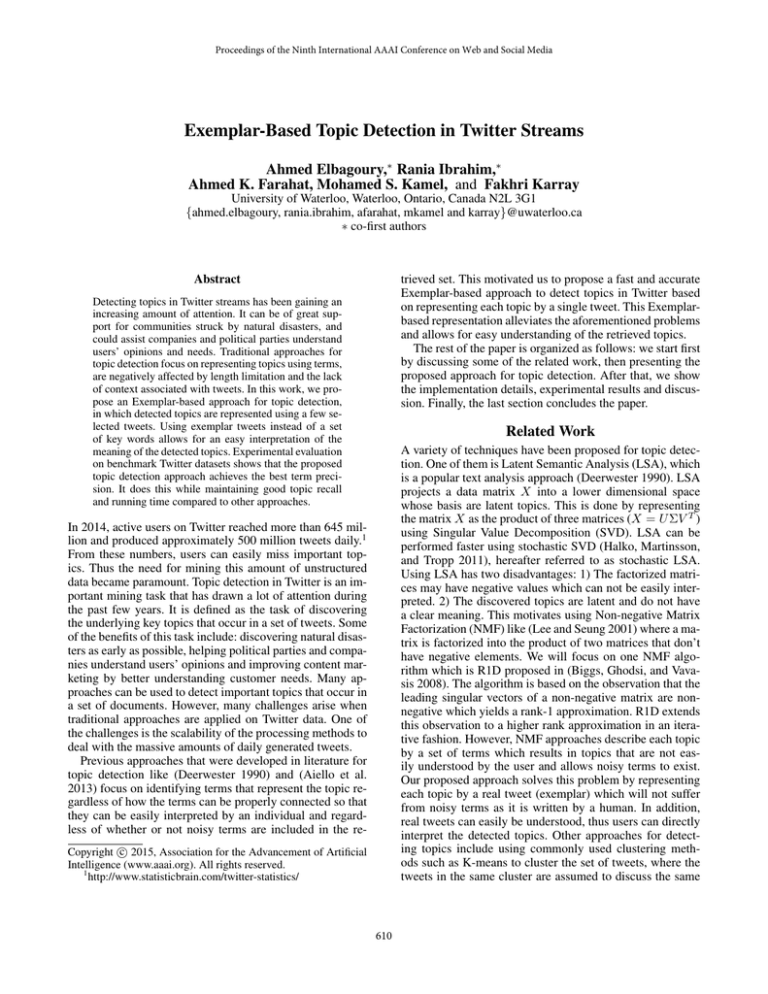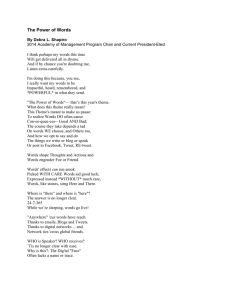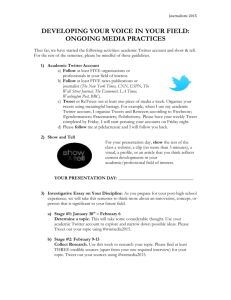
Proceedings of the Ninth International AAAI Conference on Web and Social Media
Exemplar-Based Topic Detection in Twitter Streams
Ahmed Elbagoury,∗ Rania Ibrahim,∗
Ahmed K. Farahat, Mohamed S. Kamel, and Fakhri Karray
University of Waterloo, Waterloo, Ontario, Canada N2L 3G1
{ahmed.elbagoury, rania.ibrahim, afarahat, mkamel and karray}@uwaterloo.ca
∗ co-first authors
Abstract
trieved set. This motivated us to propose a fast and accurate
Exemplar-based approach to detect topics in Twitter based
on representing each topic by a single tweet. This Exemplarbased representation alleviates the aforementioned problems
and allows for easy understanding of the retrieved topics.
The rest of the paper is organized as follows: we start first
by discussing some of the related work, then presenting the
proposed approach for topic detection. After that, we show
the implementation details, experimental results and discussion. Finally, the last section concludes the paper.
Detecting topics in Twitter streams has been gaining an
increasing amount of attention. It can be of great support for communities struck by natural disasters, and
could assist companies and political parties understand
users’ opinions and needs. Traditional approaches for
topic detection focus on representing topics using terms,
are negatively affected by length limitation and the lack
of context associated with tweets. In this work, we propose an Exemplar-based approach for topic detection,
in which detected topics are represented using a few selected tweets. Using exemplar tweets instead of a set
of key words allows for an easy interpretation of the
meaning of the detected topics. Experimental evaluation
on benchmark Twitter datasets shows that the proposed
topic detection approach achieves the best term precision. It does this while maintaining good topic recall
and running time compared to other approaches.
Related Work
A variety of techniques have been proposed for topic detection. One of them is Latent Semantic Analysis (LSA), which
is a popular text analysis approach (Deerwester 1990). LSA
projects a data matrix X into a lower dimensional space
whose basis are latent topics. This is done by representing
the matrix X as the product of three matrices (X = U ΣV T )
using Singular Value Decomposition (SVD). LSA can be
performed faster using stochastic SVD (Halko, Martinsson,
and Tropp 2011), hereafter referred to as stochastic LSA.
Using LSA has two disadvantages: 1) The factorized matrices may have negative values which can not be easily interpreted. 2) The discovered topics are latent and do not have
a clear meaning. This motivates using Non-negative Matrix
Factorization (NMF) like (Lee and Seung 2001) where a matrix is factorized into the product of two matrices that don’t
have negative elements. We will focus on one NMF algorithm which is R1D proposed in (Biggs, Ghodsi, and Vavasis 2008). The algorithm is based on the observation that the
leading singular vectors of a non-negative matrix are nonnegative which yields a rank-1 approximation. R1D extends
this observation to a higher rank approximation in an iterative fashion. However, NMF approaches describe each topic
by a set of terms which results in topics that are not easily understood by the user and allows noisy terms to exist.
Our proposed approach solves this problem by representing
each topic by a real tweet (exemplar) which will not suffer
from noisy terms as it is written by a human. In addition,
real tweets can easily be understood, thus users can directly
interpret the detected topics. Other approaches for detecting topics include using commonly used clustering methods such as K-means to cluster the set of tweets, where the
tweets in the same cluster are assumed to discuss the same
In 2014, active users on Twitter reached more than 645 million and produced approximately 500 million tweets daily.1
From these numbers, users can easily miss important topics. Thus the need for mining this amount of unstructured
data became paramount. Topic detection in Twitter is an important mining task that has drawn a lot of attention during
the past few years. It is defined as the task of discovering
the underlying key topics that occur in a set of tweets. Some
of the benefits of this task include: discovering natural disasters as early as possible, helping political parties and companies understand users’ opinions and improving content marketing by better understanding customer needs. Many approaches can be used to detect important topics that occur in
a set of documents. However, many challenges arise when
traditional approaches are applied on Twitter data. One of
the challenges is the scalability of the processing methods to
deal with the massive amounts of daily generated tweets.
Previous approaches that were developed in literature for
topic detection like (Deerwester 1990) and (Aiello et al.
2013) focus on identifying terms that represent the topic regardless of how the terms can be properly connected so that
they can be easily interpreted by an individual and regardless of whether or not noisy terms are included in the rec 2015, Association for the Advancement of Artificial
Copyright Intelligence (www.aaai.org). All rights reserved.
1
http://www.statisticbrain.com/twitter-statistics/
610
Exemplar Selection Algorithm Choosing exemplars for
detected topics can be done in an iterative manner by choosing the tweet with the highest variance in each iteration as an
exemplar for a topic. However, this approach is that it does
not guarantee the selected tweets are talking about different
topics. So after choosing each exemplar, we have to remove
its effect to ensure that no more tweets about the same topic
will be selected as exemplars of another topic. One way to
remove the effect of an exemplar ti is to disqualify the tweets
that are close to it from being exemplars, and consider the
tweet that has the highest variance of similarity and is not close to ti as the exemplar of the next topic. Figure 1 shows
an example where each node represents a tweet and its close tweets are within the dotted circle. Tweets are sorted
descendingly based on the variance of their similarities with
the rest of the tweets and each tweet is labeled in accordance
by this order. In this example, after choosing the first tweet
as the first topic exemplar, tweets 2, 3 and 4 are not chosen as
exemplars of new topics as they are very close to tweet 1 and
do not represent new topics. Tweet 5 which is the tweet with
the highest variance of similarity and not close to tweet 1
is chosen as an exemplar of a new topic. Similarly, tweets 6
and 7 are not chosen as exemplars while tweet 8 is chosen.
topic. However, K-means clustering may result in topics being distributed over several clusters. This is solved in our
approach by using exemplars (tweets) to represent the topic.
Exemplar-based Topic Detection
Notations Scalars are shown in small letters, sets are
shown in script letters, vectors are denoted by small bold
italic letters and matrices are denoted by capital letters. For
a matrix A ∈ Rn×m : A:i denotes the i-th row of A and Aij
denotes the (i, j)-th entry of A. For a vector x ∈ Rn : xi
denotes the i-th element of x
Due to the text length limitation, topic detection in short
text is more challenging than in long text. So most of the
existing approaches are not suitable for detecting topics
in short text. The basic idea behind this work is to use
Exemplar-based approach to detect topics, where each detected topic is represented using the most representative
tweet. This tweet (i.e., the exemplar) is much easier to be
interpreted by the user as it contains related terms and it represents a topic that is of direct importance to the user.
Problem Formulation Given a set of tweets T of size n,
our goal is to detect the underlying topics in this set and
represent each topic using only one tweet (exemplar). The
selection criterion should be able to detect a tweet for each
topic such that each tweet is descriptive for one topic and
discriminates this topic from other topics at the same time.
Exemplar Selection Criterion The criterion used in this
work is based on the following observation. A tweet which
is similar to a set of tweets and dissimilar to the rest of the
tweets is a good topic representative. This can be formulated by defining a similarity matrix Sn×n where Sij is the
similarity between tweet ti and tweet tj . The distribution of
similarities between each tweet ti and the rest of the tweets
can be classified into three cases:
• Tweet ti is similar to many tweets. Therefore, its similarity distribution will have low sample variance
• Tweet ti is very similar to a set of tweets and less similar to the others. Therefore, its similarity distribution will
have high sample variance
• Tweet ti is not similar to most of the other tweets. So, its
similarity distribution will have low sample variance
The tweets that fall in the second case are good candidates
for representing topics, as each tweet is very similar to a set
of tweets and therefore it can capture their underlying topic.
On the other hand, each of these tweets is different from the
rest of the tweets which means it can distinguish between
its topic and the rest of the topics. This suggests using the
variance of the similarity distribution of each tweet as a criterion for selecting topics representatives, where the sample
variance of the similarities for each tweet ti is computed as
n
1 X
var(S:i ) =
(Sij − µi )2 ,
n − 1 j=1
Figure 1: Exemplar-based illustration example
The set of exemplars E is constructed iteratively using the
following objective function, at each iteration i:
max var(S:i ), s.t. Sij ≤ ∀ti , tj ∈ E and i 6= j
ti ∈T
This objective function can be solved by iterating through
the tweets in descending order of the variance of their similarities and consider the first tweet that is not close to ti as
the exemplar of the next topic.
Speeding Up Calculations Computing a similarity matrix between a large number of tweets is very complex in
terms of running time and memory usage. Thus to be able to
handle large amounts of data, we approximate the variance
of the similarities of each tweet ti using its similarity with
fewer number m of tweets, where m < n. So the variance
of each tweet is calculated as:
m
1 X b
var(S:i ) =
(Sij − µ
bi )2 ,
m − 1 j=1
where
Pn µi is the mean of the similarities of tweet ti : µi =
1
j=1 Sij .
n
611
ber of correct keywords in the detected topics over the total
number of keywords in these detected topics) and term recall (Number of correct keywords over the total number of
keywords in the ground truth topics).
Topic precision was not used by (Aiello et al. 2013) as
not all the topics covered by Twitter appear in news sources.
For the other topic detection approaches, the top 15 keywords of each discovered topic is used as topic keywords.
While in Exemplar-based approach, each exemplar (tweet)
is used as a topic and its terms are used as topic representatives. The Exemplar-based approach uses a random set to
approximate the similarity matrix. Therefore, the Exemplar
approach was run 10 times. The average and the 95% confidence intervals of the results were reported in Figures 2 and
3. Also, the similarity measure used was the cosine similarity and the size of the random subset of tweets m used by the
Exemplar approach was set to 1000. Figures 2 and 3 show
the evaluation measures of applying different topic detection
approaches in Super Tuesday and US Elections datasets respectively. Exemplar-based was applied by setting the similarity threshold to 0.01 in US Elections and to 0.1 in Super
Tuesday, where these values were tuned empirically. Moreover, Table 1 shows the running time for the topic detection
approaches. In Super Tuesday dataset, Exemplar provided
the best term precision. Moreover, Exemplar was the best in
term recall and topic recall. For running time, the Exemplar
and K-means approaches were the fastest. For the results of
US Elections dataset, Exemplar also reached the best term
precision. For topic recall, Exemplar was the best or second best in most cases, while LSA stochastic was the best in
the first time slots. Term recall results were comparable for
all the approaches. For the running time, the Exemplar approach and K-means were again the fastest. Achieving high
term precision by the Exemplar approach is attributed to reducing the noise in the selected terms by enforcing the topics
to be real tweets as shown in table 2.
Algorithm 1: Exemplar-based Topic Detection
Data: T set of tweets, k number of topics, m size of the
random subset and similarity threshold
Result: E set of k tweets each representing a topic
b ← Select m random tweets from T
1 T
b
b)
2 S ← similarity(T , T
b ← zeros(n)
3 v
// Vector of size n
4 i←1
5 while i ≤ n do
bi ← var(Sb:i ), i ← i + 1
6
v
b ← sort(b
7 v
v, “descending”)
8 topic ← 1, i ← 1
9 while (topic < k) do
10
E.add(b
vi ), i ← i + 1
11
while similarity(b
vi , E(topic)) ≥ do
12
i←i+1
13
topic ← topic + 1
Pm b
1
b
where µ
bi = m
j=1 Sij and S is the similarity matrix between all tweets n and a random subset of size m.
It is shown empirically in the evaluation section that this
approach achieves good results with better run time. The
pseudo code of the approach is shown in Algorithm 1. Besides random selection, the set of m representative tweets
can be selected using deterministic or hybrid techniques
(Farahat et al. 2014).
Experimental Results
Two Twitter datasets were used for evaluation in this paper and were initially collected by (Aiello et al. 2013). The
datasets correspond to two distinct events which include Super Tuesday (353,650 tweets) and US Elections (578,837
tweets). We have re-constructed the two datasets as only
tweets’ ids were provided. The ground truth topics of the
datasets were constructed from news headlines reported during the events. Data is preprocessed using TMG tool2 to remove stop words and convert it to a TF-IDF representation.
The proposed topic detection approach3 is compared against
four topic detection approaches, which are: Latent Semantic Analysis (LSA), stochastic LSA (Number of iterations =
2 and oversampling = 10), Rank-1 Downdate (R1D) (Tolerance for dropping row or column = 0.1) and K-means. Kmeans centroids are chosen randomly and each run stops
when the change in its objective function is below 0.001.
Among five runs, the clusters with the minimum objective
function are used. As topics in each time slot were represented by keywords, labels for each tweet were not provided.
We have used the same measures and evaluation code used
by (Aiello et al. 2013) to evaluate the different topic detection approaches. These measures are: topic recall (Percentage of topics successfully retrieved), term precision (Num-
Conclusion
An Exemplar-based approach is proposed for detecting topics in Twitter streams. The approach selects exemplar tweets
as representatives for the detected topics based on the variance of the similarity between exemplars and other tweets.
Our Exemplar-based approach achieved the best term precision as it selects real tweets as topic representatives.
Acknowledgments This publication was made possible
by a grant from the Qatar National Research Fund through
National Priority Research Program (NPRP) No. 06-1220-1233. Its contents are solely the responsibility of the authors.
References
Aiello, L. M.; Petkos, G.; Martin, C.; Corney, D.; Papadopoulos, S.; Skraba, R.; Goker, A.; Kompatsiaris, I.; and
Jaimes, A. 2013. Sensing trending topics in twitter. Multimedia, IEEE Transactions on 15(6):1268–1282.
Biggs, M.; Ghodsi, A.; and Vavasis, S. 2008. Nonnegative
matrix factorization via rank-one downdate. In Proceedings
2
http://scgroup20.ceid.upatras.gr:8000/tmg/
Exemplar-based
code
can
be
found
at:
https://sourceforge.net/projects/topicdetectionintwitterstreams/
3
612
Table 1: Running time in seconds for topic detection approaches
Dataset
# Topics
(N)
R1D
LSA Stoch
LSA
K-means
Exemplar
N = 12
114.7866
8.3473
25.7385
6.4527
15.0808
N = 92
732.1874
103.5337
387.4809
50.1507
24.7621
N = 12
305.5000
14.4126
28.4466
8.9827
28.4967
N = 92
1796.5000
209.6554
418.7506
63.8388
45.5971
Super Tuesday
US Elections
Table 2: Sample topics detected by Exemplar-based and K-means approaches
Approach
US Elections
Super Tuesday
Exemplar
RT @AP: AP RACE CALL: Obama wins
Vermont; Romney wins Kentucky.
#Election2012
BREAKING NEWT: Gingrich wins Georgia
Republican primary (AP)
K-means
gonna popping yeahitsope twitter live wins win
obama2012 obama night election romney rt im
election2012
rt romney http gingrich georgia supertuesday
newt wins virginia ohio santorum mitt paul
primary win
1
1
1
0.8
0.8
0.6
0.6
0.6
0.4
0.2
Term Recall
0.8
Term Precision
Topic Recall
R1D
LSA Stochastic
LSA
K-means
Exemplar
0.4
0.2
0
0.2
0
20
40
60
80
0.4
0
20
Number of Topics
40
60
80
20
Number of Topics
40
60
80
Number of Topics
Figure 2: Results of topic detection on Super Tuesday dataset
1
1
1
R1D
LSA Stochastic
0.8
LSA
0.8
0.8
K-means
0.4
0.2
0.6
Term Recall
0.6
Term Precision
Topic Recall
Exemplar
0.4
0.2
0
40
60
Number of Topics
80
0.4
0.2
0
20
0.6
0
20
40
60
80
Number of Topics
20
40
60
80
Number of Topics
Figure 3: Results of topic detection on US Elections dataset
Halko, N.; Martinsson, P.-G.; and Tropp, J. A. 2011. Finding
structure with randomness: Probabilistic algorithms for constructing approximate matrix decompositions. SIAM review
53(2):217–288.
of the 25th international conference on Machine learning,
64–71. ACM.
Deerwester, Scott C., e. a. 1990. Indexing by latent semantic
analysis. JAsIs 41(6):391–407.
Farahat, A.; Elgohary, A.; Ghodsi, A.; and Kamel, M. 2014.
Greedy column subset selection for large-scale data sets.
Knowledge and Information Systems 1–34.
Lee, D. D., and Seung, H. S. 2001. Algorithms for nonnegative matrix factorization. Advances in neural information processing systems 556–562.
613






